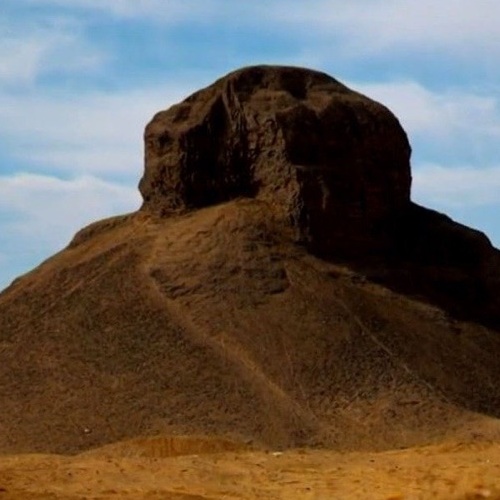No other nation in the world says ‘Welcome’ as often as the Egyptians, and every time, they mean it. While the ancient civilization of Egypt continues to amaze, contemporary Egyptians are equally remarkable.
The Black Pyramid
The Black Pyramid
The Black Pyramid, also known as the Pyramid of Amenemhet III, is a remarkable ancient structure located in Dahshur, Egypt. It is one of the three Middle Kingdom pyramids found in this area, with the other two being the Bent Pyramid of Snefru and another pyramid from the same period. This pyramid is distinguished by its unique appearance, characterized by dark-colored ruins emerging from the sand. Unlike typical pyramids, the Black Pyramid does not have a pointed top, but rather features a rocky outcrop. This distinctive appearance has led to its naming as the “Black Pyramid.”
The pyramid’s core is constructed of dark mudbrick, and it lacks the stone framework that is typical of other pyramids, which helps stabilize the structure. The shape of the Black Pyramid is believed to be the result of damage caused over centuries by robbers and harsh weather conditions, rather than an intentional design choice.
The Black Pyramid was built as a monument to honor King Amenemhet III, the last great ruler of the Twelfth Dynasty. This pyramid is particularly important because it provides insight into the architectural and construction techniques used during the Middle Kingdom period in ancient Egypt.
The pyramid was first explored in the late 19th century by researchers such as Perring, Lepsius, Georges Legrain, and Jacques de Morgan. In the 1900s, the Egyptian Antiquities Organisation conducted further investigations and discovered a beautifully preserved dark basalt pyramidion near the pyramid’s eastern side. This pyramidion, now housed in the Cairo Museum, is adorned with hieroglyphic inscriptions and provides valuable information about the pyramid’s construction and purpose.
The Black Pyramid’s internal structure is complex and includes multiple chambers and passageways. The main burial chamber, intended for King Amenemhet III, is lined with white limestone and features a vaulted roof. A large pink granite sarcophagus was found in the chamber, although it is unclear if the king was actually interred there.
The pyramid complex also includes an inner and outer mudbrick wall, as well as a mortuary temple on its eastern side. Although the temple has suffered significant damage over time, its remains suggest that it was once an impressive structure. Additionally, shaft tombs discovered near the pyramid contain the remains of Amenemhet’s family members, providing further insight into the burial practices of the period.
Interestingly, King Amenemhet III was not buried in the Black Pyramid at Dahshur. Instead, he chose to construct and be interred in another pyramid at Hawara. It is believed that structural issues with the Black Pyramid, possibly due to its location near the Nile Valley floor, led the king to abandon it in favor of the new site at Hawara.
Overall, the Black Pyramid of Amenemhet III stands as a testament to the architectural ingenuity and cultural significance of ancient Egypt during the Middle Kingdom period. Its unique appearance and historical importance make it a fascinating subject of study for archaeologists and historians alike.
Created On March 18, 2020
Updated On Aug , 2024
Giza Travel Guide



